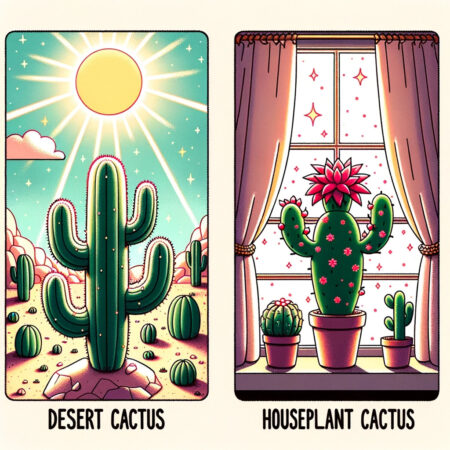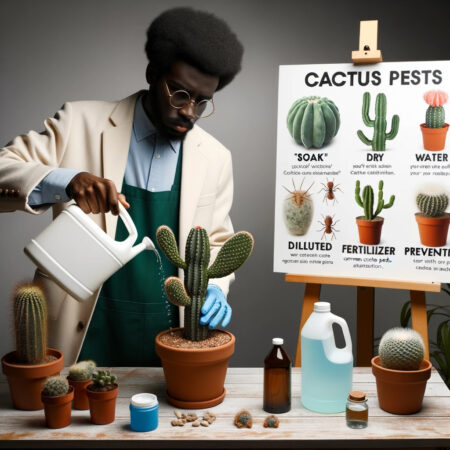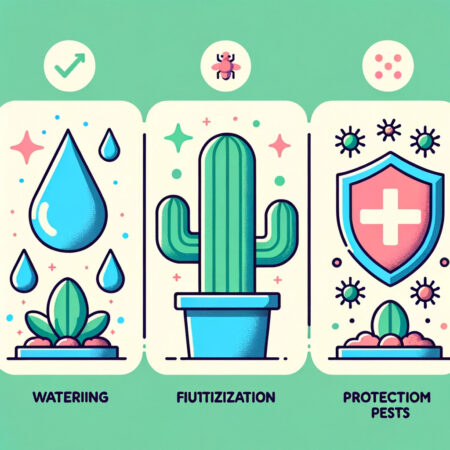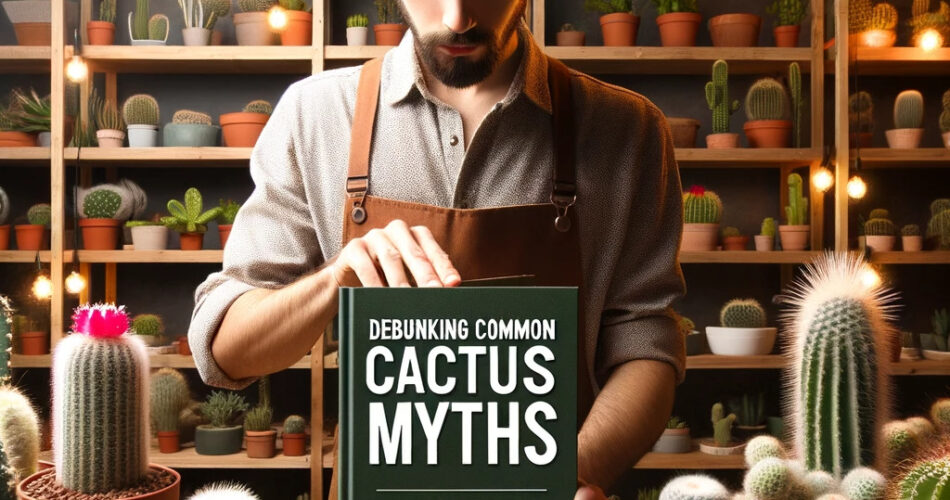Key Takeaways:
- Cacti require regular watering to thrive but overwatering can be detrimental.
- Not all cacti thrive in desert conditions, and their specific needs may vary.
- Cacti are low-maintenance plants but still require proper care and attention.
- Identifying different cactus species is important for providing the best care.
- Providing optimal light conditions and well-draining soil is crucial for cacti health.
- Proper watering techniques, appropriate fertilization, and pest prevention are vital for keeping cacti healthy.
- Cactuses have amazing adaptations to survive in harsh environments and diverse flowering species.
- Cactuses have unique cultural significance and are part of various legends and folklore.
The Truth Behind Cactus Care: Debunking Common Myths
As a cactus expert, I’ve come across several myths and misconceptions surrounding cactus care. In this section, I will debunk some of the most common myths and provide you with accurate information to help you provide the best care for your cactus.

1. Myth: Cacti Don’t Need Water
One of the most widespread myths about cacti is that they don’t need water. While it is true that cacti are adapted to survive in arid climates with minimal water availability, they still require regular watering to thrive. However, it is essential to understand that overwatering can be detrimental to cacti, as it can lead to root rot and other related issues.
The key to watering cactus is to follow the “soak and dry” method. This means thoroughly watering the soil until it is evenly moist and then allowing it to dry out completely before watering again. The frequency of watering will depend on various factors such as the cactus species, pot size, light conditions, and temperature. It’s always better to underwater than overwater, as cacti are more tolerant of drought than excessive moisture.
2. Myth: All Cactuses Thrive in Desert Conditions
While it is true that many cactus species are native to desert regions, there are numerous varieties that can thrive in different environments. Some cacti, such as the Christmas cactus (Schlumbergera spp.), prefer more moderate temperatures and higher humidity levels. These cactuses are commonly grown as houseplants and require regular watering and indirect sunlight.
It’s important to research the specific needs of the cactus species you own to ensure you are providing the appropriate conditions. Some cactus may require more shade, while others need full sunlight. Understanding the natural habitat of your cactus will help you recreate similar conditions in your home or garden.
3. Myth: Cacti Are Low-Maintenance Plants
While cacti are often touted as low-maintenance plants, they still require proper care and attention. One common misconception is that cacti can survive solely on neglect. While they are hardy plants and drought-tolerant, neglecting their basic needs can result in stunted growth and poor health.
Proper care for cacti includes providing the right light conditions, well-draining soil, and appropriate watering. It is also vital to be aware of pests and diseases that can affect cacti and take necessary preventive measures to keep them healthy.
Understanding the Unique Needs of Different Cactus Species
Each cactus species has its distinct characteristics and requirements. Understanding these differences is key to providing the best care for your cacti. In this section, we will explore the identification of different cactus species, optimal light conditions, and the right soil composition for your cactus.
1. Identifying Different Cactus Species
With over 2,000 known species of cactus, each with its unique features, it can be challenging to identify them correctly. However, there are certain characteristics to look out for when identifying cactus species.
One key aspect is the shape and structure of the cactus. There are various shapes such as columnar, globular, or cylindrical. Additionally, the presence of spines, flowers, and growth patterns can provide valuable clues for identification.
If you’re unsure of the species, there are numerous online resources, books, and forums where you can seek guidance from fellow cactus enthusiasts or consult a local cactus society or expert.
2. Providing Optimal Light Conditions for Your Cacti
Light is a crucial factor that determines the growth and overall health of cacti. Most cacti require bright, indirect sunlight for optimum growth. Placing them near a south-facing window or providing them with 12-14 hours of artificial light can help meet their light requirements.
However, it’s important to note that different cactus species have varying light preferences. Some prefer full sun exposure, while others thrive in partial shade. Researching the specific light requirements for your cactus species will ensure you provide the ideal conditions for their growth.
It’s also important to observe your cactus for any signs of sunburn or insufficient light. Sunburned cacti might display a reddish or brownish discoloration and may need to be moved to a slightly shadier location.
3. The Right Soil Composition for Your Cactus
The soil composition plays a vital role in cactus care as it influences the plant’s ability to absorb water and nutrients. Cactuses require well-draining soil to prevent root rot and other issues caused by excess moisture.
A common misconception is that cacti exclusively grow in sandy soils. While sand can be beneficial for drainage, it is not recommended to use it alone as it lacks essential nutrients. A well-balanced soil mix for cacti typically consists of a combination of potting soil, perlite, pumice, and coarse sand.
It’s important to avoid using regular potting soil or garden soil, as these tend to retain too much moisture. Preparing a well-draining soil mix will promote healthy root development and prevent waterlogged conditions.

Effective Tips and Tricks for Keeping Your Cactus Healthy
Taking good care of your cacti involves several factors, including proper watering, fertilization, and preventing common pests and diseases. In this section, we will delve into the dos and don’ts of watering, fertilizing, and pest control for your precious cactus.
1. Watering Dos and Don’ts for Different Cactus Species
Watering is a vital aspect of cactus care. As mentioned earlier, the “soak and dry” method is generally recommended. However, the specific watering needs can vary depending on the cactus species, maturity, growing season, and environmental conditions.
When watering your cacti, it’s essential to water the soil directly rather than spraying the plant. This allows the roots to absorb water efficiently. Avoid overwatering by ensuring the soil dries out completely between watering sessions.
During the winter months, many cactuses enter a dormant phase and require less frequent watering. It’s advisable to reduce the watering frequency and monitor the moisture levels in the soil during this period.
2. Fertilizing Your Cacti: What You Need to Know
While cactuses are generally low-maintenance plants, they can benefit from occasional fertilization. However, it’s crucial to choose the right type and frequency of fertilizer to avoid causing harm to the plants.
A balanced, water-soluble fertilizer formulated specifically for cactus and succulents is usually the best choice. It’s recommended to dilute the fertilizer to half or quarter strength and apply it during the growing season, typically in spring and summer.
During the winter months, it’s advisable to withhold fertilizer as the plants are in a slow or dormant phase. Over-fertilization can lead to nutrient burn and other adverse effects, so it’s important to follow the instructions provided by the manufacturer.
3. Preventing Common Cactus Pests and Diseases
Cacti are generally resilient and less prone to pests and diseases compared to other plants. However, certain pests can still pose a threat to their health.
Common pests that affect cacti include mealybugs, spider mites, and scale insects. Regularly inspecting your cacti for any signs of pest infestation is crucial. If you notice tiny white cotton-like substances, webbing, or small bumps on the plant’s surface, it’s an indication of a pest problem.
To control and prevent pests, you can use organic insecticides specifically formulated for cactus or take measures such as isolating affected plants and manually removing pests with a soft brush or cotton swab dipped in rubbing alcohol.
In terms of diseases, root rot caused by overwatering is one of the most common issues. To prevent root rot, ensure your cactus are planted in well-draining soil, use appropriate watering techniques, and maintain good airflow around the plants.

Myth or Fact: Exploring Fascinating Cactus Trivia
Cacti are not only captivating plants but also possess several interesting facts and folklore. In this section, we will explore their amazing adaptations to harsh environments, the surprising diversity of flowering cacti, and the legends and folklore associated with these unique plants.
1. Cactus and their Amazing Adaptations to Harsh Environments
Cacti have evolved remarkable adaptations to survive in extreme conditions, such as deserts. One of their most notable adaptations is their ability to store water in their stems or leaves, allowing them to withstand prolonged periods of drought.
Other adaptations include their spines, which serve multiple purposes – protecting the plant from predators and providing shade, reducing water loss through transpiration.
Some cacti species also have specialized root systems that efficiently absorb water from the soil. The roots can quickly absorb water during rainfall and store them for later use during dry periods.
2. The Surprising Diversity of Flowering Cacti
When most people think of cactus, they often picture them as thorny plants with no flowers. However, this is a common misconception as many cacti species produce vibrant and beautiful flowers.
Flowering cacti can display a wide range of colors, shapes, and sizes. From the iconic blooms of the Saguaro cactus (Carnegiea gigantea) to the delicate flowers of the Easter cactus (Rhipsalidopsis), the diversity of flowering cacti is truly astounding.
Many cacti species rely on specialized pollinators such as bats, birds, or insects for cross-pollination. The fascinating symbiotic relationship between cactus and their pollinators has resulted in a diverse array of flower shapes and scents to attract specific pollinators.
3. Cactus Legends and Folklore from Around the World
Cacti have long been intertwined with various legends and folklore around the world. In Native American cultures, cactus often symbolize endurance, strength, and protection. The saguaro cactus, in particular, holds great cultural significance for Native American tribes in the southwestern United States.
In Mexican folklore, the cactus is associated with various myths and traditions. The iconic Mexican holiday, Day of the Dead, features images of cacti, particularly the sacred Peyote cactus (Lophophora williamsii), which is believed to have spiritual properties.
Throughout history, cactus have also been used for medicinal and ornamental purposes, and their unique characteristics have inspired artists, writers, and gardeners across the globe.
As a cactus enthusiast, exploring these legends and folklore adds an extra layer of fascination to these already captivating plants.
Conclusion
In conclusion, debunking common cactus myths and understanding the unique needs of different cactus species is crucial for providing optimal care to these remarkable plants. By following the accurate information provided in this comprehensive guide, you can ensure your cactus thrive and remain healthy.
Remember to debunk the myth that cacti don’t need water and provide appropriate watering based on the “soak and dry” method. Understand that not all cacti thrive in desert conditions and adjust the light and environmental conditions accordingly. Acknowledge that cactus require proper care and attention, dispelling the myth that they are low-maintenance plants.
Identifying different cactus species, providing optimal light conditions, and using well-draining soil are vital for their health and growth. Effective tips and tricks such as watering dos and don’ts, appropriate fertilization, and pest prevention will further contribute to their well-being.
Lastly, exploring fascinating cactus trivia, including their amazing adaptations, stunning diversity of flowering cactus, and legends from different cultures, adds to the allure of these unique plants. Cacti are more than just ornamental plants; they have a rich history and cultural significance that continues to captivate enthusiasts all over the world.
FAQ
Question: Can cactus survive without water? – No, while cacti are adapted to survive in arid climates with minimal water availability, they still require regular watering to thrive. Overwatering can be detrimental to cacti.
Question: Do all cactuses thrive in desert conditions? – No, not all cacti thrive in desert conditions. Some cacti, like the Christmas cactus, prefer more moderate temperatures and higher humidity levels. It’s important to research the specific needs of your cactus species.
Question: Are cactus low-maintenance plants? – While cacti are often considered low-maintenance, they still require proper care and attention. Neglecting their basic needs can result in stunted growth and poor health.
Question: How can I identify different cactus species? – Identifying cactus species can be challenging, but you can look for characteristics such as shape, spines, flowers, and growth patterns. Online resources, books, and cactus societies can also provide guidance.
Question: What are the optimal light conditions for cactus? – Most cacti require bright, indirect sunlight. However, different species have varying light preferences. Some prefer full sun, while others thrive in partial shade. Researching your specific cactus species is important.
Question: What type of soil is best for cacti? – Cacti require well-draining soil to prevent root rot. A well-balanced soil mix typically consists of potting soil, perlite, pumice, and coarse sand. Avoid using regular potting soil or garden soil.
Question: How should I water my cacti? – The “soak and dry” method is generally recommended. Thoroughly water until the soil is evenly moist, then allow it to dry out completely before watering again. The frequency will depend on various factors.
Question: How can I keep my cactus healthy and prevent pests? – Proper watering, appropriate fertilization, and regular inspection for pests are important. Use organic insecticides for pest control and ensure good airflow around the plants to prevent root rot.




Comments